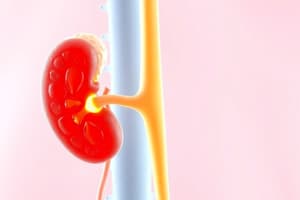Podcast
Questions and Answers
What is the primary consequence of albumin escaping the capillary wall?
What is the primary consequence of albumin escaping the capillary wall?
- Hypoproteinemia leading to decreased osmotic pressure (correct)
- Increased lymphatic drainage
- Increased reabsorption of fluids
- Decreased hydrostatic pressure
What is a primary role of sodium in the extracellular fluid (ECF)?
What is a primary role of sodium in the extracellular fluid (ECF)?
- Maintaining fluid balance and action potentials (correct)
- Balancing anions between fluid compartments
- Facilitating CO2 transport in blood
- Neurotransmitter release
Which condition could lead to hypernatremia?
Which condition could lead to hypernatremia?
- Reduced calcium levels
- Decreased sodium output
- Excessive fluid intake
- Dehydration or increased sodium intake (correct)
How does lymphatic obstruction affect interstitial fluid?
How does lymphatic obstruction affect interstitial fluid?
Which electrolyte is most abundant in intracellular fluid (ICF)?
Which electrolyte is most abundant in intracellular fluid (ICF)?
What is the primary role of albumin in the process of reabsorption?
What is the primary role of albumin in the process of reabsorption?
Which statement accurately describes filtration in the capillaries?
Which statement accurately describes filtration in the capillaries?
How do lymphatic capillaries contribute to fluid balance in the body?
How do lymphatic capillaries contribute to fluid balance in the body?
What is the main difference between active and passive transport of fluids?
What is the main difference between active and passive transport of fluids?
What triggers the movement of water into a cell during active transport?
What triggers the movement of water into a cell during active transport?
What triggers the production of atrial natriuretic peptide (ANP)?
What triggers the production of atrial natriuretic peptide (ANP)?
What is the primary effect of atrial natriuretic peptide (ANP) on the kidneys?
What is the primary effect of atrial natriuretic peptide (ANP) on the kidneys?
Which of the following best describes edema?
Which of the following best describes edema?
Which condition can lead to hypoproteinemia?
Which condition can lead to hypoproteinemia?
What is the main cause of pleural effusion?
What is the main cause of pleural effusion?
How does inflammation contribute to edema?
How does inflammation contribute to edema?
What happens when venous pressure increases in capillaries?
What happens when venous pressure increases in capillaries?
What is a common consequence of hypoproteinemia?
What is a common consequence of hypoproteinemia?
What is the primary function of electrolytes in the body?
What is the primary function of electrolytes in the body?
Which of the following correctly describes the distribution of body fluids?
Which of the following correctly describes the distribution of body fluids?
What is the role of non-electrolytes in the body?
What is the role of non-electrolytes in the body?
According to Sterling's Law of the Capillary, what is the direction of fluid movement?
According to Sterling's Law of the Capillary, what is the direction of fluid movement?
Which statement about intracellular fluid (ICF) composition is correct?
Which statement about intracellular fluid (ICF) composition is correct?
Which of these correctly characterizes interstitial fluid?
Which of these correctly characterizes interstitial fluid?
What happens to the body if fluids and electrolytes are not properly balanced?
What happens to the body if fluids and electrolytes are not properly balanced?
What proportion of extracellular fluid (ECF) is typically blood plasma?
What proportion of extracellular fluid (ECF) is typically blood plasma?
What primarily regulates the gain of water in the body?
What primarily regulates the gain of water in the body?
What triggers the thirst mechanism in the body?
What triggers the thirst mechanism in the body?
Which hormone is released when dehydration occurs?
Which hormone is released when dehydration occurs?
What is the effect of aldosterone on the kidneys?
What is the effect of aldosterone on the kidneys?
What is the role of the RAAS system in fluid balance?
What is the role of the RAAS system in fluid balance?
How does facilitated diffusion differ from osmosis?
How does facilitated diffusion differ from osmosis?
What characterizes diffusion in the context of cell membrane transport?
What characterizes diffusion in the context of cell membrane transport?
Which factor primarily influences fluid output regulation?
Which factor primarily influences fluid output regulation?
Which condition is characterized by excessive sodium loss and muscle weakness?
Which condition is characterized by excessive sodium loss and muscle weakness?
What can excessive potassium levels in the body lead to?
What can excessive potassium levels in the body lead to?
Which condition is least likely to cause increased levels of parathyroid hormone (PTH)?
Which condition is least likely to cause increased levels of parathyroid hormone (PTH)?
Hypocalcemia can lead to which of the following symptoms?
Hypocalcemia can lead to which of the following symptoms?
Which electrolyte imbalance is characterized by excessive thirst and frequent urination?
Which electrolyte imbalance is characterized by excessive thirst and frequent urination?
What is a common symptom of hyperchloremia?
What is a common symptom of hyperchloremia?
Excessive intake of which vitamin can lead to hypercalcemia?
Excessive intake of which vitamin can lead to hypercalcemia?
Which condition is characterized by low levels of chloride in the body?
Which condition is characterized by low levels of chloride in the body?
What symptom might indicate hyperkalemia?
What symptom might indicate hyperkalemia?
Increased chloride levels can lead to which of the following conditions?
Increased chloride levels can lead to which of the following conditions?
Flashcards
Fluid
Fluid
Water and dissolved substances in the body's fluid compartments.
Electrolyte
Electrolyte
Substances that form ions in water, crucial for fluid balance & functions.
Intracellular Fluid (ICF)
Intracellular Fluid (ICF)
Fluid inside cells.
Interstitial Fluid
Interstitial Fluid
Signup and view all the flashcards
Intravascular Fluid
Intravascular Fluid
Signup and view all the flashcards
Fluid Compartment Ratio (Men)
Fluid Compartment Ratio (Men)
Signup and view all the flashcards
Sterling's Law
Sterling's Law
Signup and view all the flashcards
Electrolyte Composition (Intracellular)
Electrolyte Composition (Intracellular)
Signup and view all the flashcards
Filtration in Capillaries
Filtration in Capillaries
Signup and view all the flashcards
Reabsorption in Capillaries
Reabsorption in Capillaries
Signup and view all the flashcards
Lymphatic Capillaries
Lymphatic Capillaries
Signup and view all the flashcards
Active Transport
Active Transport
Signup and view all the flashcards
Passive Transport
Passive Transport
Signup and view all the flashcards
Osmosis
Osmosis
Signup and view all the flashcards
Facilitated Diffusion
Facilitated Diffusion
Signup and view all the flashcards
Diffusion
Diffusion
Signup and view all the flashcards
Fluid Balance
Fluid Balance
Signup and view all the flashcards
Water Gain & Loss
Water Gain & Loss
Signup and view all the flashcards
Thirst Mechanism
Thirst Mechanism
Signup and view all the flashcards
RAAS
RAAS
Signup and view all the flashcards
ADH Hormone
ADH Hormone
Signup and view all the flashcards
Hypoproteinemia
Hypoproteinemia
Signup and view all the flashcards
Lymphatic Obstruction
Lymphatic Obstruction
Signup and view all the flashcards
Sodium's Importance
Sodium's Importance
Signup and view all the flashcards
Potassium's Importance
Potassium's Importance
Signup and view all the flashcards
Hypernatremia
Hypernatremia
Signup and view all the flashcards
Renin Release Inhibition
Renin Release Inhibition
Signup and view all the flashcards
Edema
Edema
Signup and view all the flashcards
Causes of Edema
Causes of Edema
Signup and view all the flashcards
Venous Pressure
Venous Pressure
Signup and view all the flashcards
Inflammation
Inflammation
Signup and view all the flashcards
Hypokalemia
Hypokalemia
Signup and view all the flashcards
Hypocalcemia
Hypocalcemia
Signup and view all the flashcards
What causes increased PTH?
What causes increased PTH?
Signup and view all the flashcards
Hyperchloremia
Hyperchloremia
Signup and view all the flashcards
Hypochloremia
Hypochloremia
Signup and view all the flashcards
What are the symptoms of hyponatremia?
What are the symptoms of hyponatremia?
Signup and view all the flashcards
What are the symptoms of hypernatremia?
What are the symptoms of hypernatremia?
Signup and view all the flashcards
What is the function of aldosterone?
What is the function of aldosterone?
Signup and view all the flashcards
Study Notes
Fluid and Electrolyte Definition
- Fluids: Water and dissolved substances within the body's compartments
- Electrolytes: Substances that dissociate in water into ions, controlling osmosis, maintaining acid-base balance, and carrying electric current necessary for enzyme activities.
- Non-electrolytes: Substances that don't dissociate, aren't electrically charged, and are mainly organic compounds (lipids, glucose, urea, creatinine).
- Homeostasis of cells depends on balanced fluids and electrolytes regulating volume, distribution, solute concentrations, and pH.
Body's Fluid Compartments
- ICF (Intracellular Fluid): Fluid within cells (cytoplasm)
- ECF (Extracellular Fluid):
- Interstitial fluid: Fluid surrounding cells and blood vessels.
- Intravascular fluid: Fluid within arteries and veins (blood plasma)
Body Fluid Distribution
- Women: 45% solids, 55% liquids
- Men: 40% solids, 60% liquids
- 2/3 of body fluids are intracellular
- 1/3 of body fluids are extracellular (80% interstitial, 20% blood plasma)
Composition of Body Fluids
| Compartment | Na+ | HCO3- | HPO42- | Protein | Potassium | Cl- |
|---|---|---|---|---|---|---|
| Intracellular | Low | None | High | High | Low | High |
| Interstitial | High | High | None | None | Low | High |
| Intravascular | High | High | None | High | Low | High |
Movement of Fluid: Intravascular → Interstitial
- Filtration: Blood hydrostatic pressure pushes fluids, solutes, and albumin out of capillaries at the arteriole end.
- Reabsorption: Albumin in the interstitial space creates osmotic pressure, drawing fluid back into the bloodstream.
- Lymphatic Capillaries: Excess interstitial fluid is absorbed by lymphatic capillaries and returned to blood.
Movement of Fluid: Interstitial → Intracellular
- Active Transport: Protein carriers move ions across cell membranes using ATP (energy).
- Passive Transport:
- Osmosis: Water moves across membranes based on concentration gradients
- Facilitated Diffusion: Larger molecules use carrier proteins to move across membranes
- Diffusion: Nutrients, gases, and wastes move across based on concentration gradients
- The regulation of fluid balance between compartments is essential.
Fluid Balance
- Water gain and loss must be equal.
- Major sources of water gain are ingestion.
- Loss occurs through urine, feces, sweat, and breath.
- Fluid intake is regulated by thirst mechanism, RAAS, and ADH.
- Fluid output is regulated by ANP.
Thirst Mechanism
- Thirst center in hypothalamus triggered by decreased saliva production, increased blood osmolarity, or decreased blood volume.
- Thirst helps restore body water levels.
RAAS (Renin-Angiotensin-Aldosterone System)
- A series of chemical reactions that causes kidneys to reabsorb sodium and water, leading to increased blood volume.
ADH (Antidiuretic Hormone)
- Released by the hypothalamus in response to dehydration, triggering the kidneys to retain water and reduce urine output, increasing blood volume.
Fluid Imbalances
- Edema: Abnormal fluid accumulation in interstitial space due to venous pressure, hypoproteinemia, inflammation, or lymphatic obstruction.
- Effusion: Fluid accumulation in body cavities (pleural, peritoneal, or pericardial).
Electrolyte Imbalances (Examples)
- Hypernatremia: High sodium; symptoms include thirst, dry mouth, decreased urine output.
- Hyponatremia: Low sodium; symptoms include nausea, confusion, and abdominal cramps.
- Hyperkalemia and Hypokalemia: High and Low potassium, respectively
- Hypercalcemia, Hypocalcemia, Hyperchloremia and Hypochloremia: High and Low calcium, chloride, respectively .
- These imbalances can lead to various health problems, and accurate diagnosis and treatment are crucial.
Studying That Suits You
Use AI to generate personalized quizzes and flashcards to suit your learning preferences.




